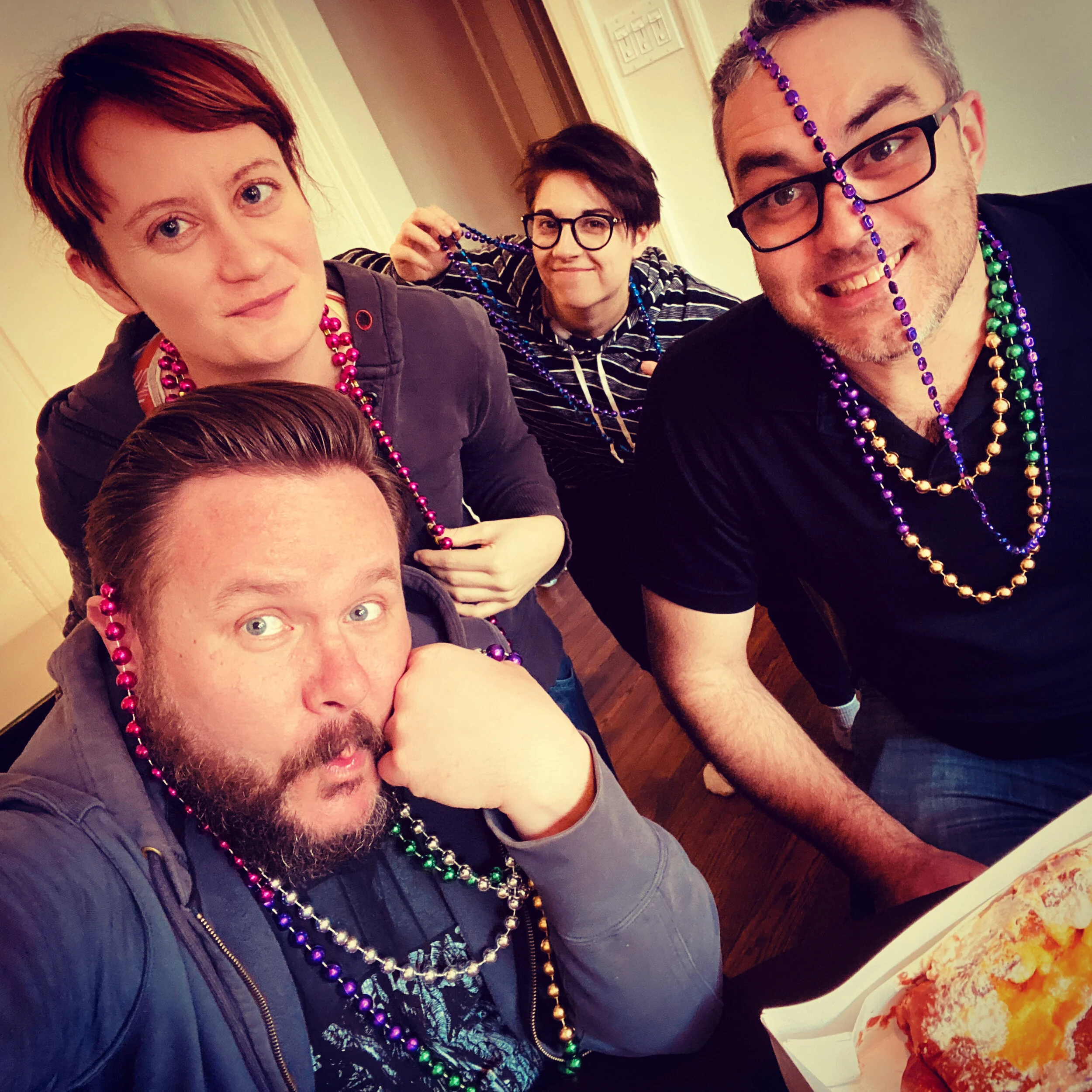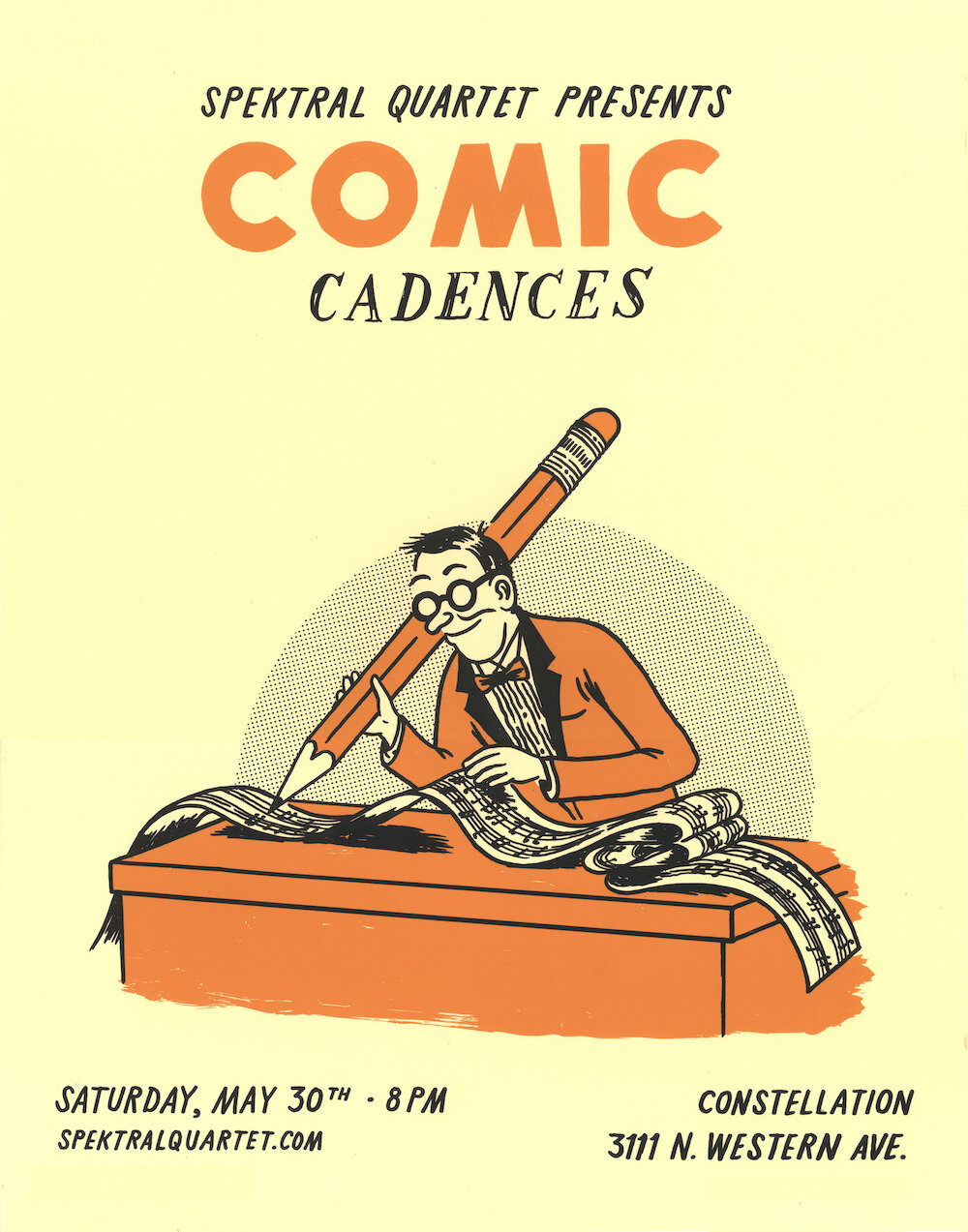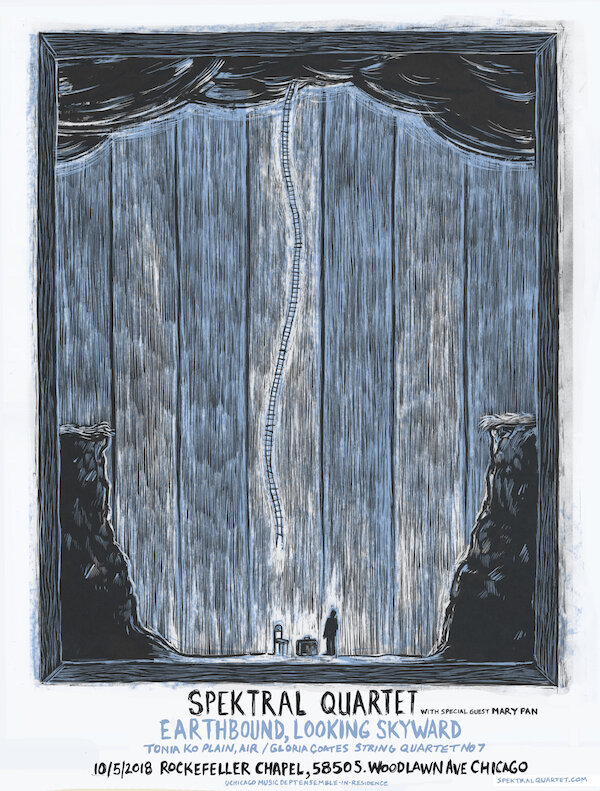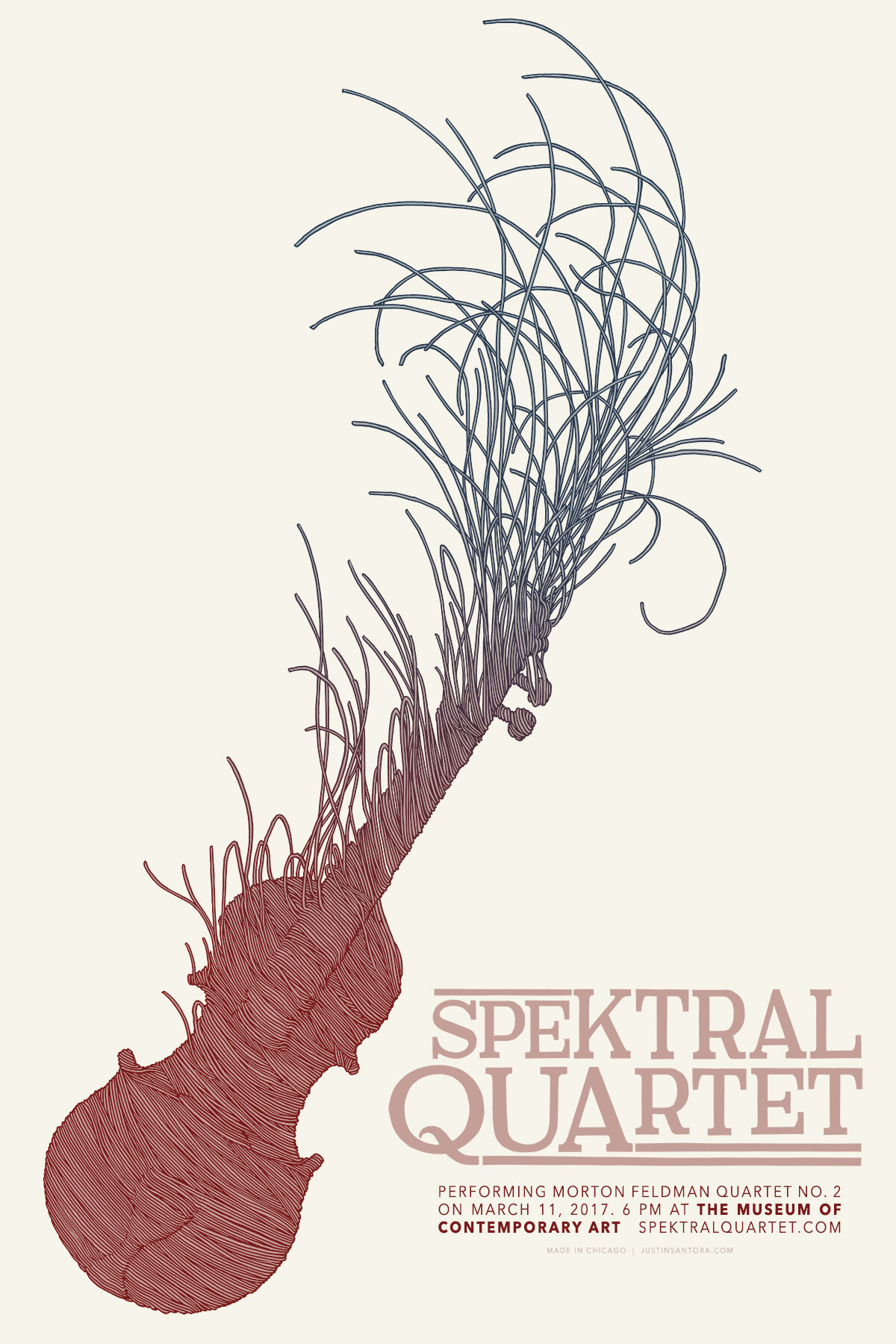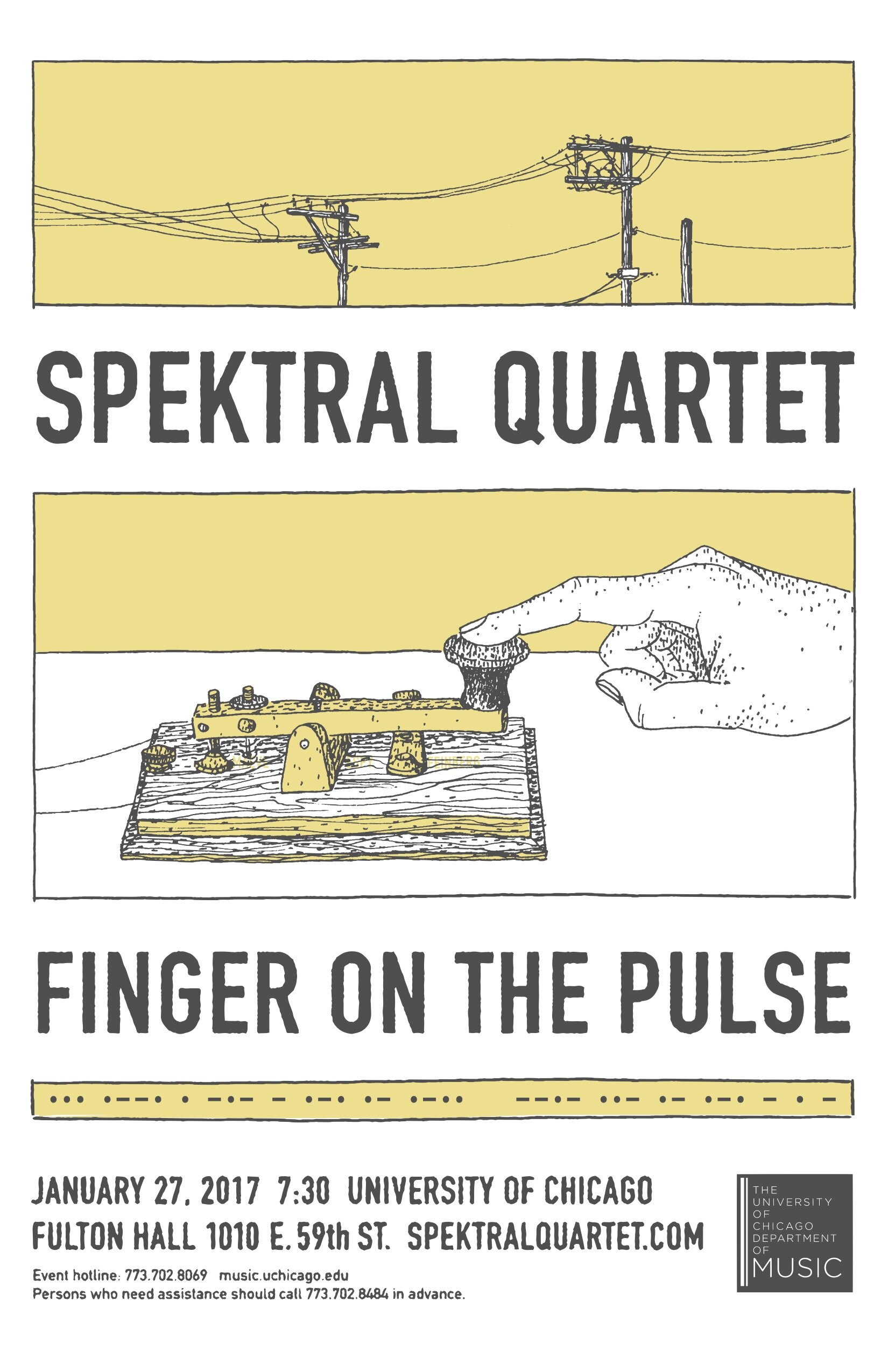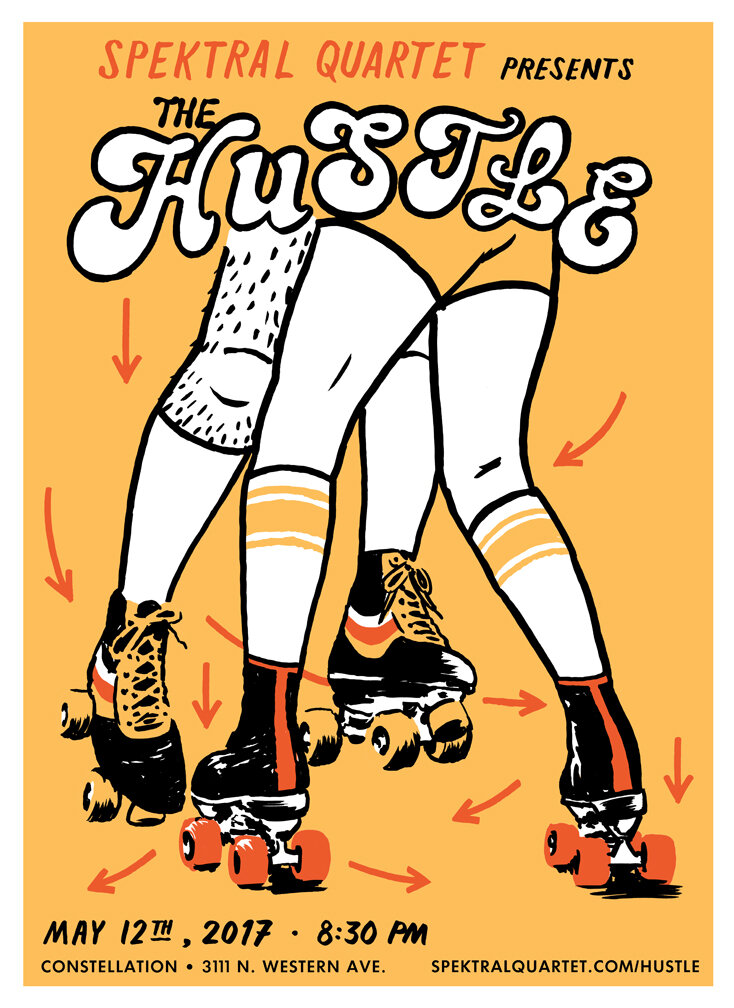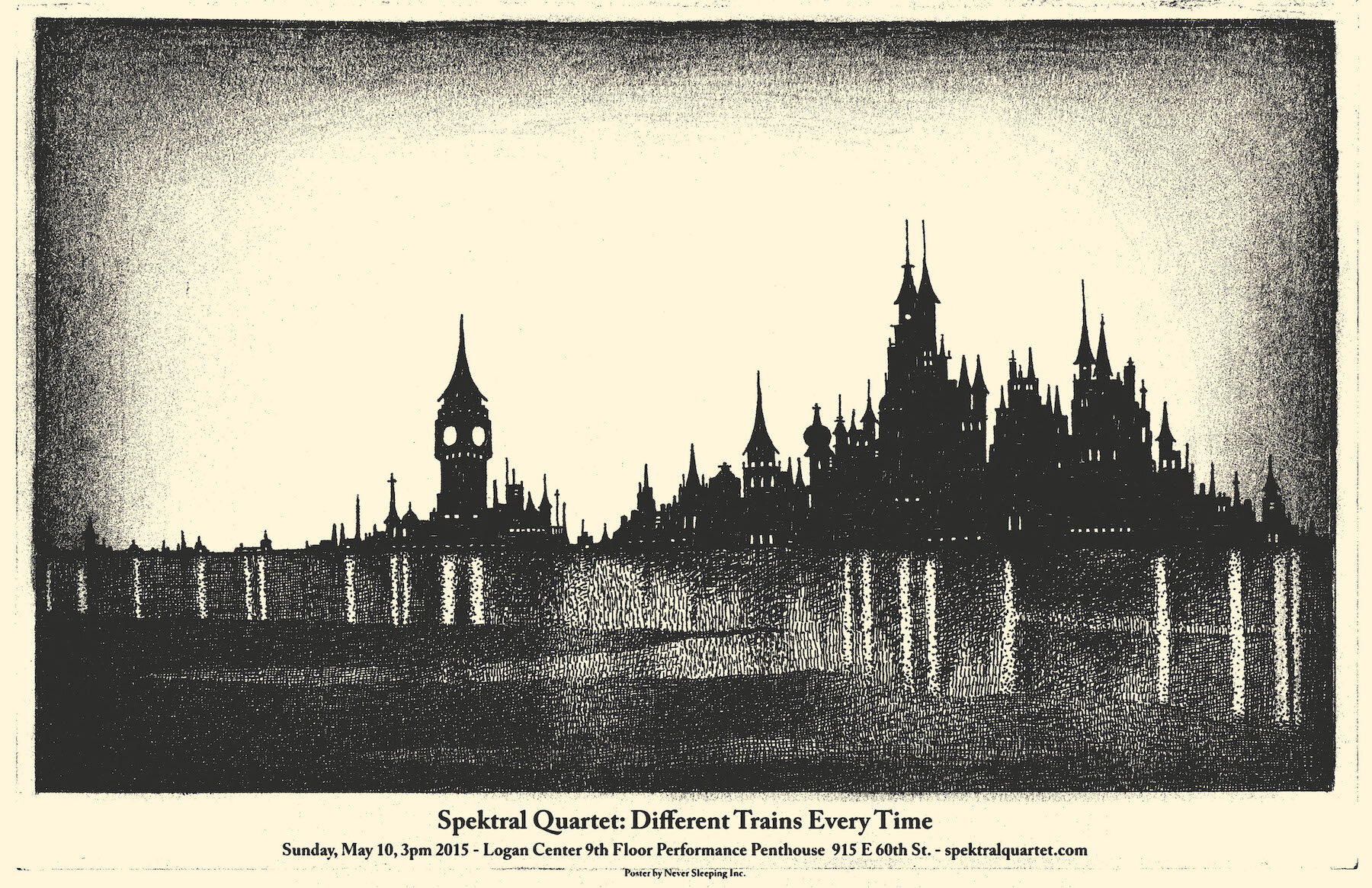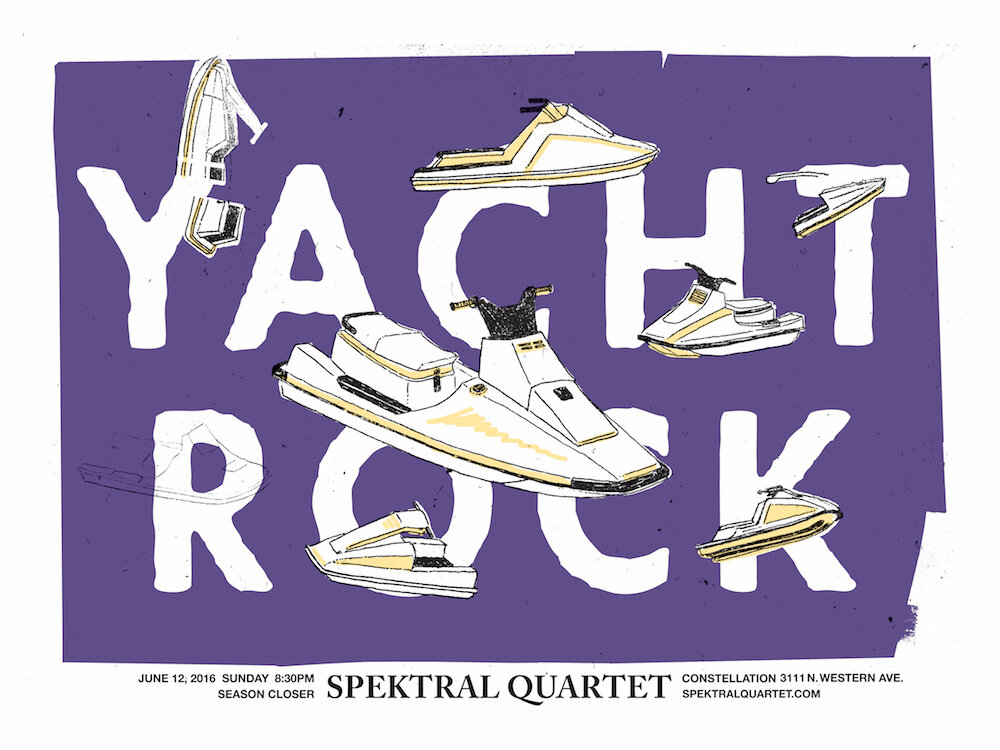Performers have long sprinkled contempo- rary pieces in classical programs like raisins in a pudding. Proposed affinities provide an often tenuous rationale for inclusion. This project by the Chicago-based Spektrals ex- plodes that formula. Everything about it is anatomized, theorized, and curated to pro- voke listeners into forming their own con- nections among musical units. That there are connections is assumed.
Schoenberg, in his essay “Brahms the Progressive,” lauds not only Brahms’ late harmonic daring but also the asymmetry of his phrasing: a composer should be “afraid to offend by repeating over and over what can be understood at one single hearing, even if it is new.” (Such “elitist” mid-centu- ry orthodoxy drove Philip Glass to additive rebellion.) The first example Schoenberg cites is Brahms’ C Minor Quartet op. 51, no. 1—which opens the Spektrals’ album. It’s followed by Schoenberg’s Third Quar- tet, which introduced his 12-tone method (even notes should not be repeated too soon!). I don’t expect to hear more meticu- lous or penetrating readings of either piece. Ruth Crawford Seeger’s Quartet 1931 fully holds its own in this company, with equally dedicated playing.
Part Two of the album features works by living composers, many of which pose technical challenges that are easy to under- estimate. Sam Pluta’s binary/momentary logics: flow state/joy state asks the quartet to enact the timbres and parallel pitch fluidity of electronic instruments. Anthony Cheung’s Real Book of Fake Tunes adds Claire Chase on flutes to spoof the conventions of jazz fakebooks. Charmaine Lee’s Spinals calls for group improvisation around Lee’s vo- calized effects. The whole project takes its name from performer, scholar, and MacAr- thur “genius” George Lewis’ wide-ranging String Quartet 1.5: Experiments in Living—a title that quotes in turn from a John Stuart Mill passage proposing that “individuality should assert itself.”
That’s the playlist—if you begin and just keep going. But the Spektrals want you to choose your own adventure. University of Chicago professor Patrick Jagoda helped them “gamify” the experience for the era of Spotify and sampling. In the spirit of Flux- us, and of Brian Eno and Peter Schmidt’s Oblique Strategies, they commissioned Na- talie Bontumasi to design a striking deck of 20 cards backed with collages by øjeRum. Each card identifies a track; shuffling and drawing determines playback order. From a pack of 60 smaller “bridge” cards, bear- ing a wild assortment of words, the listener chooses one that suggests a conceptual link between each musical unit and the one last heard. (For those forgoing the card set and hi-res files, Romanian firm Critique Gam- ing has produced a free online emulator with mp3-quality audio at eil.spektralquar- tet.com.) While this tarot-tracking can be whimsical, its serious purpose is to prompt close listening and new discoveries with each hearing.
Since the pieces couldn’t all be record- ed in the same venue, Grammy-winning engineer Dan Nichols, a self-confessed “maximalist,” built a multi-armed “Love- craft array” for four pairs of spot mikes so the players could see each other—and so a single virtual space could be conjured in- dependently of physical location. The per- fectionist Spektrals chose the best phrases from many takes to assemble Nichols’ “ransom note that doesn’t sound like one.”Even at 176.4kHz/24-bits, the seamless result is the most intimate, musically adven- turous simulacrum imaginable. Baudrillard would be proud.
Visions for the Future – See you later, 2020
This has been a…trying…year, but the time away from the stage has also given us the opportunity to reevaluate our dreams and goals as an ensemble. What has also been made crystal clear is the interdependence between us and the communities we serve. More specifically, you have shown us with your generosity that you want to help us past this difficult stretch – and that is so incredibly affirming and inspiring to us.
The New Yorker: Notable Performances and Recordings of 2020
Notable Recordings of 2020
“Debussy Rameau”; Víkingur Ólafsson (Deutsche Grammophon)
Liza Lim, “Extinction Events and Dawn Chorus”; Peter Rundel and Stefan Asbury conducting the Klangforum Wien, with Sophie Schafleitner and Lorelei Dowling (Kairos)
Ethel Smyth, “The Prison”; James Blachly conducting the Experiential Orchestra, with Sarah Brailey and Dashon Burton (Chandos)
“Experiments in Living”: Music of Brahms, Schoenberg, Crawford Seeger, Pluta, Cheung, Charmaine Lee, George Lewis; Spektral Quartet, with Claire Chase (New Focus)
The 2020 Spektral Holiday Gift Guide!
This holiday season, give them a gift that says, Hey, I actually like you!
For the discerning culture vulture
This over-stimulated so-and-so is almost impossible to shop for, but this year you are going to introduce them to the next big thing. Hailed by The New Yorker as an “ingenious presentation…sensationally well-played,” Experiments in Living is not just an album, but an intriguing, Tarot-like card game featuring luxurious art that is sure to lure them into its mind-bending world.
For the fashion trendsetter
While everyone else in 2020 is scurrying onto the Afghan-as-poncho bandwagon, you and your crew are embracing the timeless black T. But you’re kicking it up a notch, natch, updating this classic look by a few shades to “graphite,” and emblazoning the pectoral area with the insignia of one of classical music’s (deep, deep) underground heroes.
For the questionably-coiffed
Whether it’s a dead beaver sitting atop your scalp or just a typical pandemic-bed-head scenario, a beanie is the perfect choice for the gym, the grocery, or the board room. Distract them from your freakish rat’s nest even further with a nod to your favorite string quartet on planet earth.
For the art-lover with an empty wall
You’ve stashed away a five-year supply of Campbell’s Soup and gin, but how are you going to stay sane, puttering around all those blank corridors? With a hand-silkscreened, signed Spektral poster, of course. Relive those halcyon days before the zombie apocalypse – when you saw Spektral burn it to the ground at Constellation or The Hideout – with these gorgeous pieces.
For the budding curiosity-seeker
You know that what Spektral produces is always going to fire up your synapses, swell your heart, or at the very least, make you bust a gut. But does your niece Calamari know that? What about your frenemy, Thad? They deserve to experience Spektral’s unusual approach to chamber music, too, and this will get them on their path to musical enlightenment. A free VIP pass to an upcoming show, and a combination of stickers, temporary tattoos, buttons, and/or multiple album downloads will prove to them that you care.
And this is just the tip of the proverbial iceberg. Head on over to our Merch page to find even more fantastic gifts for your loved ones…or your own self.
A Closer Listen: The Year's Best Album Covers (2020)
Spektral Quartet ~ Experiments in Living (New Focus Recordings)
Artist: øjeRum
Over the years, Copenhagen’s øjeRum has released a healthy amount of music, while gracing dozens of albums with his art. We’ve always wanted a book, a card deck or other collection of these images ~ and in 2020, we got our wish. This striking cover art is only the introduction to a generous art deck that accompanies the double album Experiments in Living.
A Closer Listen: The Year's Best Packaging (2020)
BEST PACKAGING OF THE YEAR
Spektral Quartet ~ Experiments in Living (New Focus Recordings)
We knew this was something special from the moment it was announced. After years of gracing album covers (and recording dozens of his own), collage artist øjeRum created a series of art cards for this project. They arrive in a keepsake box, accompanied by two decks of word cards and the suggestion to pair words with images and images with songs, producing an endless supply of listening experiences and interpretations.
New York Times: Best Classical Music of 2020
Including older and contemporary works on the same program is nothing new. But two string quartets took such era-spanning perspectives to fresh heights this year.
Brooklyn Rider had the temerity to sequence new pieces between the movements of Beethoven’s Opus 132 on their double-disc set “Healing Modes.” And the Spektral Quartet’s digital-only double album, “Experiments in Living,” invited listeners to hit “shuffle” on their streaming service of choice. (Alternately, one could use the group’s specially designed tarot cards to determine a new sequence during each listen.)
…
On one randomized tour through Spektral’s playlist, I was astonished to discover how some of the players’ darting articulations during the first movement of Brahms’s String Quartet No. 1 proved a perfect appetizer for the serrated edges of Sam Pluta’s “binary/momentary logics: flow state/joy state.”
You can, of course, go through both albums such that every work proceeds in its correct order. But these scrambled yet crisply played recordings also manage to suggest that different eras and styles might have something useful to offer each other.
The New Yorker: Two Thriving String Quartets
If any chamber group can rival the jack’s quarantine frenzy, it is the Spektral Quartet, a wide-ranging ensemble based in Chicago. The members of the Spektral—Clara Lyon, Maeve Feinberg, Doyle Armbrust, and Russell Rolen—have kept themselves occupied by launching two absorbing live-stream programs, the Floating Lounge and New Music Help Desk, which mix music and discussion. The group has also made several appearances in the virtual realm. As part of a streaming series hosted by Cal Performances, in Berkeley, the Spektral joined the Haitian-American composer, vocalist, and flutist Nathalie Joachim to reprise material from Joachim’s entrancing album “Fanm d’Ayiti” (New Amsterdam), which mixes arrangements of Haitian folk songs with Joachim’s original compositions inspired by songs in Kreyòl. During a tense season, the complex radiance of Joachim’s musical sensibility may have the effect of palpably lowering your blood pressure. The group will soon celebrate its tenth anniversary with a virtual gala titled Keep Spektral Weird.
The Spektral’s major project of the benighted year 2020, though, has been an album titled “Experiments in Living,” which is certain to appear on my year-end list of notable recordings. It is a tour-de-force survey of repertory, classic and modern, demonstrating in almost textbook fashion how nineteenth-century Romanticism evolved into twentieth-century modernism and then into the all-devouring experimentalism of recent decades. If you listen to the album in the given order, you will begin with Brahms’s Quartet in C Minor, from 1873, in which the traditional process of thematic development is pursued with a kind of microscopic intensity that presages the breakdown of conventional harmonic structures. That breakdown is achieved in Schoenberg’s Third String Quartet (1927), even as the exposition and development of musical ideas obey classical rigor. A further breakdown takes place in Ruth Crawford Seeger’s String Quartet (1931), a monument of American modernism; in its Andante, discrete thematic ideas dissolve into a continuously undulating texture. From there, the path is open to a group of latter-day American composers: Sam Pluta, Anthony Cheung, Charmaine Lee, and George Lewis.
Yet the Spektral players encourage their listeners to break from proceeding in a straight-ahead chronological fashion. They propose that the tracks be shuffled, but not in the sense of the shuffle feature in Apple Music, which randomizes tracks on a playlist. Rather, the physical packing for “Experiments in Living” comes with a deck of tarot-style illustrated cards, one for each track on the album. The listener is invited to shuffle the cards, lay them out on the table, and determine the track order by flipping them. A set of smaller cards are printed with adjectives—“labyrinthine,” “relentless,” “frisky,” “deviant,” and so on—which listeners can use to tease out connections among the various pieces. You choose one to identify continuities on the playlist.
As one who relies too much on adjectives professionally, I made sparing use of the smaller cards, but I enjoyed the physicality of the shuffling. The cards have a lovely touch of the occult about them, as if a fortune-teller were pointing up secret connections. And, indeed, resemblances crop up all over, especially when one of the historical composers butts against a living one. Rapidly skittering figures in Pluta’s “binary/momentary logics: flow state/joy state” pick up from Crawford Seeger’s mercurial textures. A delicate interplay of short motives in Cheung’s “The Real Book of Fake Tunes,” for flute and string quartet—Claire Chase joins the Spektral players on the recording—is akin to the contrapuntal games of the Schoenberg. To hear the fractured vocalizations of Lee’s “Spinals” after the Brahms’s vigorous finale risks whiplash, yet the transition from one to the other had the revelatory shock of a masterly cinematic cut.
At the end of the “official” sequence comes Lewis’s “Experiments in Living,” from which the album’s title comes. Lewis found the phrase in John Stuart Mill’s “On Liberty,” in a passage discussing the freedom of individuals to express themselves within a harmonious social whole. The composer writes, “I’m looking for listeners to experience the volatility of memory, resistance, and hope.” This is the heftiest of the contemporary pieces, and, in it, various strands from the older works seem to come into play, as if the composer were making a grand synthesis of string-quartet tradition even as he unleashed the devices of the post-1945 avant-garde. I felt a peculiar sense of connection between Lewis and Brahms, although I had difficulty pinpointing just what it was. Eventually, I realized that the players’ application in the Brahms of the seemingly old-fashioned gesture of portamento, sliding lushly from note to note, forms an unexpected link to Lewis’s thoroughgoing use of glissando.
In the end, the Spektral’s ingenious presentation is simply to invite active and repeated listening—to move the music from the background to the foreground, to read it like a book. The album also invites repeat encounters because it is sensationally well played. The account of the Brahms is a feast of rhythmic clarity and lyrical thrust. The Schoenberg, so often cluttered and frantic-sounding in performance, has flow and dance. Extreme precision of intonation and articulation highlights the fact that the Crawford Seeger is an essentially perfect score, every note charged with purpose. The same meticulousness governs the group’s approach to the contemporary pieces, yet fury comes to the fore when called for. The Spektral has accomplished the signal service of obliterating the dividing line between past and present, tradition and avant-garde; chronological barriers collapse, and the sounds roam free.
– Alex Ross
Strad Magazine: A collection of contrasting music that’s more than just a game of chance
For a release whose individual pieces seem intentionally not to belong together (there’s even an online, tarot-style app to select tracks in apparently random order), this wide-ranging, sometimes breathtakingly audacious offering from the Chicago-based Spektral Quartet makes a lot of sense. What holds it together, in fact, are the Spektral players’ incisive, compelling performances, which quite miraculously feel as if the players are discovering their repertoire for the first time, with all the joy and wonder that entails, yet also conveying works they’ve known for a lifetime.
The Daily Californian: One of many Fanm - Nathalie Joachim dazzles in Fanm d’Ayiti
Fanm d’Ayiti begins with breathless harmonics from Spektral Quartet. The translucent layers welcome in Nathalie Joachim’s petalled voice — perhaps the only word that can describe her tender vocals. Her lyrics are in Kreyòl (Haitian Creole) and her timbre is positively floral, sweet and geometric in that Fibonacci way.
This semester, Cal Performances has gone virtual — the performances are prerecorded onstage, with documentary-style features of the artists speaking about their works. Joachim stands in a luminous seafoam dress that drapes in stiff folds. Behind her are the wings of the masked quartet: Clara Lyon (violin), Maeve Feinberg (violin), Doyle Armbrust (viola) and Russell Rolen (cello). Their eyes follow the hinge of Joachim’s jaw, the strain of her lips with lengthened words, for signs. And signs arise, providing them opportunities for synchronicity. Alternating between voice and flute, Joachim flows together with the strings to ride a pitch or turn, offering a shelter from dissonance and syncopation, a beautiful reprise.
San Francisco Classical Voice: Nathalie Joachim Has a Long Reach on Fanm d’Ayiti
At the start of Nathalie Joachim’s “Madan Bellegarde” — a short, somber Haitian folksong describing a Haitian woman’s condemnation — the taut voice of an elder Ipheta Fortuma floats out of a hidden speaker. Joachim, standing center stage in a flood of purple light, surrounded by the masked, physically distanced members of the Spektral Quartet, hears Fortuma’s voice and nods, listening. The scene is intimate: the glint of an earring, the repositioning of a sneaker, the contour of a cheek, the hint of a smile in an eye.
As Fortuma’s voice fades, Joachim signals to the ensemble with a breath, and the group embraces the melody left behind: Joachim, first singing the tune herself, then playing it on flute; the quartet, harmonizing it in different registers, adorning it with insistent sustains; the electronics, triggered by Joachim, providing gentle blooms of rhythm and color. The melody of “Madan Bellegarde,” passed from Fortuma to Joachim and her ensemble, becomes the sign of a tender occasion, the mark of varied distances; for its sounds are celebrations of lives overlooked, and its shaking, primary voice — Fortuma’s — is that of Joachim’s own grandmother.
Kill Yr Idols: The Movie Issue
Ghosts in the Machine
Spektral Quartet is one of the many, many excellent string quartets on the contemporary scene (the 21st century has, so far, been the era of the string quartet in classical music, every new, young quartet that comes along seems to be already playing at the highest level, which I have to think is a tribute to what conservatory training is like nowadays, at least for string players). Everybody plays well and has a repertoire that stretches from the 18th to the 21st century—something that used to be novel is now commonplace, which is a good thing for the music but can make it hard to mark one group, or performance or recording, as compelling vis-a-vis the others.
Spektral presents itself in a way that does separate the group from the crowd. There is the willingness to go deep into the literature—they’re one of the few groups to actually sit down and perform Morton Feldman’s String Quartet No. 2—and also an attitude that balances seriousness and personality. They are trying to get beyond the album/program format, an idea that in normal circumstances would be quirky but that now, when we are stuck in the album format, is a relief from the creeping monotony of the listening experience. At the end of the summer, they put out Experiments in Living, a digital double-album (over two hours) that has two salient features. One is the adept, passionate playing that encompasses Brahms’ String Quartet No. 1, Ruth Crawford Seeger’s String Quartet (one of the great works in the literature), Schoenberg’s String Quartet No. 3, and new pieces; The Real Book of Fake Tunes, written by Anthony Cheung and with Claire Chase added on flute, Charmaine Lee’s Spinals, with Lee performing with her voice and using electronics, Sam Pluta’s binary/momentary logics: flow state/joy state, and the title piece, courtesy of George Lewis.
Yes, you say, great old and new music, superb! But what’s so different about this? Since this is a digital release, the quartet set up a Tarot-deck based randomizer (they call it a choose-your-own-adventure thing) where you can pick cards, or generate a random draw, and shuffle the tracks of the album (it’s here, you need to enter an email address and your name but don’t need to opt-in to any marketing list).
In the scheme of things, which here means my own experiences in and knowledge of music, this is cute and not much of a thing. If you download the album, or play it through a streaming service, you can shuffle tracks. It’s a make-your-own-playlist that millions of people do all the time. But in the world of classical music, this is something of a step into the unknown. I’m agnostic on whether or not it’s a useful step, but any and every question toward the hidebound, bourgeois protocols and ceremonies of the recording and performing format is worthwhile, because the need is acute.
And, to give Spektral credit, they’ve got something going on today, Friday, October 9, that looks exciting. The group has been working with Anna Thorvaldsdottir (the most important contemporary composer) on a work she made for them, Enigma (with video artist Sigurdur Gudjonsson). The pandemic cancelled the premiere and tour, but Spektral is going to record the music, and that starts off with them getting together to rehearse it again. And you can be there! A, if you will, fly-in-the-hair experience.
This is a happening over the intertubes, of course, 4-5:30pm EST. Go to this page to RSVP. I think this kind of thing has long legs. Don’t give me rebranded shuffle, let me see how this stuff is made, let me see how you get from that first note on the page to the finished performance. Rehearsals, well run, are more fascinating than performances, and I really think that’s true for the vast non-classical music public as well. Rehearsing through a piece of composed music is a resource, and a deep one, classical music has at its disposal, and no other music has this. Use it, people.
Fifteen Questions Interview with the Spektral Quartet: Moments of Risks
Collaborations can take on many forms. What role do they play in your approach and what are your preferred ways of engaging with other creatives through playing together or just talking about ideas?
CLARA LYON: Collaboration is everything. It’s the quickest way to learn and to get to the heart of an idea. Working with Spektral for six years has really taught me that and I’m fully indoctrinated in this idea now. We bounce ideas off each other constantly, but we regularly work with other artists so that we are always learning, always drawing on new perspectives, and challenging our notions.
Collaboration is not a substitute for doing your own work, it’s the natural extension, to see how your work coexists and contends with the work of others as in a dialogue, to learn more about a kind of practice, and to inspire and be inspired. I also have some projects outside of Spektral that draw on different disciplines: I’m working now on a project that involves a composer, a visual artist, a poet, an animator, and a set designer. What our work says to each other, and the words we use to say it, has been very revealing.
Each collaboration takes it’s own form because of the people involved. Building in a long period of getting to know each other is important, because the collaborative process tends to develop exponentially as it goes through the process of accumulating a shared vocabulary. Discussing priorities is important. Knowing what each other loves is important: sharing inspirations and love for other art, eating meals together, etc. Spektral has started a whole series of digital events based around this idea of getting to know what our collaborators love: in our “Floating Lounge” series we ask a guest to share a playlist that we listen to live, in front of an audience. It’s been huge fun and a great way to get to know new music.
How is preparing music, playing it live and recording it for an album connected? What do you achieve and draw from each experience personally? How do you see the relationship between improvisation and composition in this regard?
CLARA LYON: A live concert performance is a fluid organism. An album is a snapshot of a moment in time. The difference in construct/product makes it essential to consider what risks are worth it when recording. For instance, it bothers me when a Classical album sounds overly produced or like the artist is playing it too safe. But if you go too far the other way, you may end up with a bunch of takes that are just not usable at all because they’re not technically consistent enough.
You have to determine those moments of risks that you just can’t live without, and practice them in different conditions so that you’ll be able to execute them on the day of the session. When you’re on the group’s clock and it’s not a solo record, it’s even more important to be able to consistently get your ideas across in the music so you’re not dragging the session down. For this album, it was a priority to us that the music feel as live and spontaneously inspired as possible. We recorded in longer chunks than we usually do: sometimes playing whole movements over and over, to replicate that experience of live performance just for our own continued inspiration.
Composition and improvisation….both still have a framework, a structure. The difference is sort of related to that risk factor idea. In an improvised piece you are responding freely to a devised set of parameters or are defining those parameters in real time. It can feel super risky! In a composed piece, where many more parameters are defined, the question as an interpreter becomes: “How much can you color outside the lines before your musical gesture begins to not resemble the composition anymore?” The process of answering this question is a way to consider your artistic voice and priorities.
The Road to Sound: August 2020 in Experimental Music
“Experiments in Living is another somewhat retrospective album, traversing the classic sound of Johannes Brahms and the always surprising vocal improvisations of Charmaine Lee alike. Spektral Quartet shows off their chops on this album — they’re equally adroit at performing Ruth Crawford Seeger’s biting early 20th-century modernism as they are George Lewis’ wild experimentations. There’s a current of energy that runs through each piece that ties the different sonic worlds together, creating the monolithic package of modern string quartet music that Experiments in Living represents.”
Chicago Reader: Spektral Quartet’s Experiments in Living upends the timeline to stake out a fresh vantage point
“The through line of Spektral Quartet’s first studio release in four years, Experiments in Living, is that there is no through line—at least on the surface. The double album covers 150 years of history, from Brahms to living lions such as George Lewis, but rather than foist a chronological or thematic flow onto the recording, the Chicago ensemble encourage nonlinear pathways and heavy use of the “shuffle” feature. Preorders of the album through their site even come with a deck of tarot-like cards with collages from Danish artist ØjeRum; each card corresponds to a different track, so that every reading reveals a distinct playlist.
On one of my shuffled listens, I pinballed from the skittering major-key rejoinder in the first movement of Brahms’s String Quartet no. 1 into its shadowy analogue in the opening of Schoenberg’s String Quartet no. 3. In the same session, I hurtled from Binary/Momentary Logics: Flow State/Joy State by Chicago-based composer Sam Pluta, which glows with the heat of a live wire, straight into Lewis’s String Quartet no. 1.5, “Experiments in Living,” a 16-minute cataclysm that pulls the rug out from under you at every turn. I was struck by how both pieces simultaneously embrace and rail against the universe. The album also features a commanding interpretation of Ruth Crawford Seeger’s 1931 String Quartet (a masterwork as timelessly radical as The Rite of Spring) and a definitive version of Anthony Cheung’s The Real Book of Fake Tunes (commissioned for Spektral and flutist Claire Chase, who performs here with her usual sensitivity and verve), as well as a freewheeling improvisation with experimental vocalist Charmaine Lee called Spinals.
Experiments in Living endorses a topsy-turvy view of time that casts the familiar in a new light and presents wet-ink works like they’ve been around since the 19th century, but the whimsy and effervescence of Spinals make it stand out even on this delectably disorienting album.”


